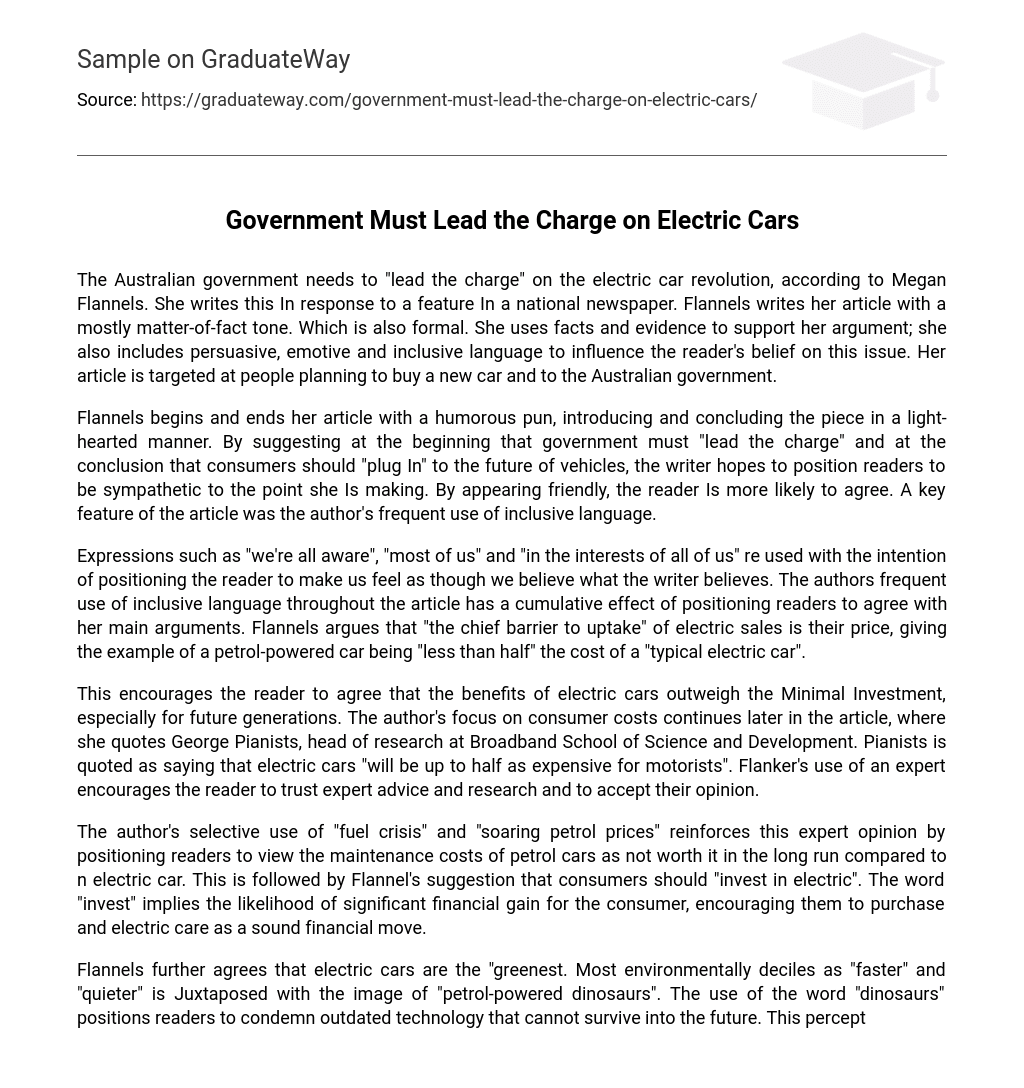The Australian government needs to “lead the charge” on the electric car revolution, according to Megan Flannels. She writes this In response to a feature In a national newspaper. Flannels writes her article with a mostly matter-of-fact tone. Which is also formal. She uses facts and evidence to support her argument; she also includes persuasive, emotive and inclusive language to influence the reader’s belief on this issue. Her article is targeted at people planning to buy a new car and to the Australian government.
Flannels begins and ends her article with a humorous pun, introducing and concluding the piece in a light-hearted manner. By suggesting at the beginning that government must “lead the charge” and at the conclusion that consumers should “plug In” to the future of vehicles, the writer hopes to position readers to be sympathetic to the point she Is making. By appearing friendly, the reader Is more likely to agree. A key feature of the article was the author’s frequent use of inclusive language.
Expressions such as “we’re all aware”, “most of us” and “in the interests of all of us” re used with the intention of positioning the reader to make us feel as though we believe what the writer believes. The authors frequent use of inclusive language throughout the article has a cumulative effect of positioning readers to agree with her main arguments. Flannels argues that “the chief barrier to uptake” of electric sales is their price, giving the example of a petrol-powered car being “less than half” the cost of a “typical electric car”.
This encourages the reader to agree that the benefits of electric cars outweigh the Minimal Investment, especially for future generations. The author’s focus on consumer costs continues later in the article, where she quotes George Pianists, head of research at Broadband School of Science and Development. Pianists is quoted as saying that electric cars “will be up to half as expensive for motorists”. Flanker’s use of an expert encourages the reader to trust expert advice and research and to accept their opinion.
The author’s selective use of “fuel crisis” and “soaring petrol prices” reinforces this expert opinion by positioning readers to view the maintenance costs of petrol cars as not worth it in the long run compared to n electric car. This is followed by Flannel’s suggestion that consumers should “invest in electric”. The word “invest” implies the likelihood of significant financial gain for the consumer, encouraging them to purchase and electric care as a sound financial move.
Flannels further agrees that electric cars are the “greenest. Most environmentally deciles as “faster” and “quieter” is Juxtaposed with the image of “petrol-powered dinosaurs”. The use of the word “dinosaurs” positions readers to condemn outdated technology that cannot survive into the future. This perception is reinforced by the Miter’s use of inclusive language as she describes the petrol vehicles most drivers are “still getting around in”.
The word “still” further implies time has passed and they are unsuitable for the future because they are unsuitable. Readers are led to believe they know this on the inside but are yet to make the Jump to the new technology, but the shift is inevitable over time. A further argument in support of government subsidies for electric vehicles is that ‘there are the environmental and health benefits”. Flannels encourages a perception of a “health crisis” by her use of statistics, such as that “2. % of all deaths in Australia” are due to air pollution, or that air pollution costs the INS Department of Health “$4. 7 billion” a year. These statistics, and especially the author’s use of italic text to emphasis the word “billion” encourage the reader to think more about the amount of money spent and to feel anxiety for future, especially for children. Readers are also encouraged to think about the long term health risk, therefore are more inclined to accept the author’s idea.
In conclusion, the author uses a variety of different techniques to prove her contention that the government needs to do more to encourage Australians to choose electric cars over “petrol-powered dinosaurs”. She puts forward her reasons for promoting electric cars in a way that uses statistical evidence to position the reader to accept her arguments and reinforces this with inclusive and emotive language, appealing to readers sense of responsibility for future generations and also the readers desire to belong to the good side. ‘





